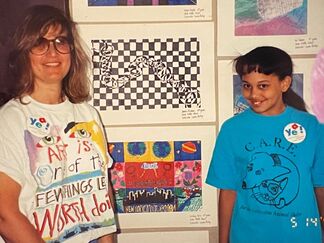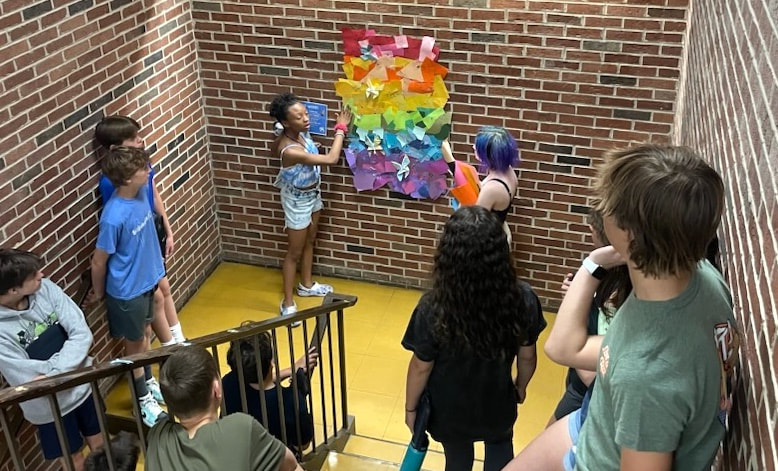 Middle school me with my art teacher
Middle school me with my art teacher
I believe that art and design touch every aspect of our lives, and that everyone is intrinsically creative.
During the delicate years of middle school, when life is in flux and students question their ability and potential, I strive to grow their creative confidence. Together we build a classroom where individuals feel seen, known, and valued in a community that intentionally explores diverse artists, artworks, and art making activities. All visual art –– painting, drawing, printmaking, sculpture, ceramics, photography, filmmaking, design, architecture, crafts –– is interesting and valuable.
In the art studio, every student should have equitable access to receive what they need to reach their creative potential. They should feel empowered to be themselves and follow their personal interests, while also challenged to courageously stretch, try new things, and contribute to the growth of our community through presenting and responding to each others’ works. I strive to center student voices and celebrate our cultural, academic, and interest based differences. I build individual relationships through personal check-ins and encouraging independent study, and build classroom community by guiding collaborative exercises.
To nurture this inclusive classroom environment, we regularly and informally connect as humans, whether remote or together. We build intellectual comfort with each other through discussions while “slow-looking” at art. We build creative comfort with each other by showing works-in-progress with each other and offering gentle critiques. Teaching methods are balanced between teacher-directed skill building exercises and student-directed personal prompts. Students develop technical skill through direct instruction and skill progression, and develop imagination through exploration and play with materials. Students develop awareness of and appreciation for a wide variety of arts from international artist spotlights that act as windows, mirrors, and doors into the breadth of the human experience.
Student work is collected in personal art portfolios. Growth in skill or mindset is assessed by self-reflection. While finished student work frequently is visually pleasing, the true value is in the process, not the visual perfection of a final product, therefore student reflection on their artistic process –– shared in writing, presentation, or discussion –– is my preferred assessment.
I believe teaching can never be mastered and am committed to professional growth. I seek to constantly recognize areas for growth and seek opportunities to improve. To deepen my understanding of culture and its impact on teaching and learning, I intentionally read, travel, and take workshops to become aware of my positionality and decenter my personal experience as universal truth. To stay fresh with my technical skills, I regularly take art classes and workshops. To stay connected to the complex social and emotional experience of a learner, I reflect on and write about my own learning experiences. To center the student experience, I routinely implement student evaluations to get feedback on the culture and climate of the classroom and make appropriate adjustments.
I am committed to contributing to the profession by participating in committees at the school level, leading workshops at the district level, partnering with arts institutions at the local level, and presenting at conferences and publishing curriculum at the national level.
After 19 years I still find teaching in the classroom to be an interesting intellectual and interpersonal challenge that is stimulating, important, and rewarding. As long as I continue to believe it to be so, I commit to do my best to support the arts in my community and the love of learning in my students.
During the delicate years of middle school, when life is in flux and students question their ability and potential, I strive to grow their creative confidence. Together we build a classroom where individuals feel seen, known, and valued in a community that intentionally explores diverse artists, artworks, and art making activities. All visual art –– painting, drawing, printmaking, sculpture, ceramics, photography, filmmaking, design, architecture, crafts –– is interesting and valuable.
In the art studio, every student should have equitable access to receive what they need to reach their creative potential. They should feel empowered to be themselves and follow their personal interests, while also challenged to courageously stretch, try new things, and contribute to the growth of our community through presenting and responding to each others’ works. I strive to center student voices and celebrate our cultural, academic, and interest based differences. I build individual relationships through personal check-ins and encouraging independent study, and build classroom community by guiding collaborative exercises.
To nurture this inclusive classroom environment, we regularly and informally connect as humans, whether remote or together. We build intellectual comfort with each other through discussions while “slow-looking” at art. We build creative comfort with each other by showing works-in-progress with each other and offering gentle critiques. Teaching methods are balanced between teacher-directed skill building exercises and student-directed personal prompts. Students develop technical skill through direct instruction and skill progression, and develop imagination through exploration and play with materials. Students develop awareness of and appreciation for a wide variety of arts from international artist spotlights that act as windows, mirrors, and doors into the breadth of the human experience.
Student work is collected in personal art portfolios. Growth in skill or mindset is assessed by self-reflection. While finished student work frequently is visually pleasing, the true value is in the process, not the visual perfection of a final product, therefore student reflection on their artistic process –– shared in writing, presentation, or discussion –– is my preferred assessment.
I believe teaching can never be mastered and am committed to professional growth. I seek to constantly recognize areas for growth and seek opportunities to improve. To deepen my understanding of culture and its impact on teaching and learning, I intentionally read, travel, and take workshops to become aware of my positionality and decenter my personal experience as universal truth. To stay fresh with my technical skills, I regularly take art classes and workshops. To stay connected to the complex social and emotional experience of a learner, I reflect on and write about my own learning experiences. To center the student experience, I routinely implement student evaluations to get feedback on the culture and climate of the classroom and make appropriate adjustments.
I am committed to contributing to the profession by participating in committees at the school level, leading workshops at the district level, partnering with arts institutions at the local level, and presenting at conferences and publishing curriculum at the national level.
After 19 years I still find teaching in the classroom to be an interesting intellectual and interpersonal challenge that is stimulating, important, and rewarding. As long as I continue to believe it to be so, I commit to do my best to support the arts in my community and the love of learning in my students.
